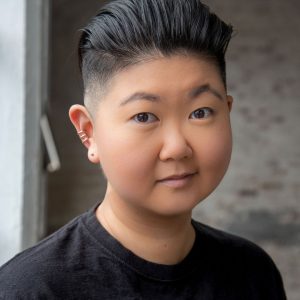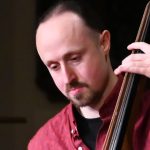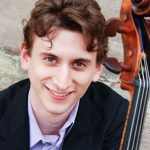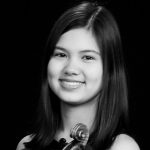This concert celebrates the 400th birthday of Jean de La Fontaine, the French poet best known for his fables, and all art that evokes a story—music and spoken text that tells a story, or even just reminds us of the magic of storytelling.
Guest Artist: Sagan Chen

Sagan Chen is an award-winning actor, filmmaker, and theatre artist, and thrilled to be joining the Sebastians for this concert! As a queer nonbinary Chinese-American, they strive for their artistry to reflect an awareness of social responsibility and intersectionality of representation. Onstage: Two Mile Hollow (Yale), Six Years Old, Stone, and delicacy of a puffin heart (Corkscrew Theater Festival), Something for the Fish (CPR), Exposed Bone (The PIT). Onscreen: High Maintenance, Here We Wait and Sideways Smile. Directing: Dartmouth College, festivals: Samuel French OOB, Frigid, Corkscrew, Women in Theatre. Narrator of Ana On The Edge. Team at Gersh and Mosaic. Education: Dartmouth College, LAMDA, BLCU. diane-chen.com IG: @sagan.chen
About the Music
Telemann released the individual movements to his Gulliver’s Travels Suite one-by-one in his music magazine in 1728, the same year that Jonathan Swift’s Gulliver’s Travels was translated into German. Telemann must have known his audience would enjoy following along with Gulliver’s adventures—from the dances of the tiny Lilliputians and the giant Brobdingngians; to the sleepy, dreaming Laputians; and finally the dialogue between the civilized Houyhnhnms and the untamed Yahoos.
Biber dedicates the Battalia to Bacchus, god of wine, theater, and debauchery in general. These sorts of pieces are not uncommon, but Biber’s is particularly colorful. The first movement is filled with contrasts of loud and soft as well as special effects like pizzicato (plucking the strings) and col legno (striking the strings with the wood part of the bow). In the second movement, Biber imagines a rowdy bar, writing in Latin, “Here it is completely dissonant, for thus are the drunks accustomed to bellow with different songs.” Biber’s scene also includes a march with ad hoc “drum” (the violone, with paper rattling between the strings), a prayerful aria (perhaps the soldiers’ thoughts before the battle?), the battle itself, complete with gunshots (dramatic snap pizzicati), and finally, a lament for the wounded soldiers.
Froberger’s tombeaux are all tailored for the individual in whose honor he was writing. In the case of “Monsieur Blancheroche,” or Blancrocher—a famous French lutenist—Froberger notes that this one should be played quite slowly and with great freedom. Blancrocher perished by falling down a flight of stairs, and Froberger was unfortunately there for the terrible accident. In the second half of the piece, Froberger’s tolling funeral bell in the bass of the harpsichord underlines his sadness.
François Couperin wrote Le Parnasse, ou l’Apothéose de Corelli to honor the great Arcangelo Corelli, whose music was incredibly popular in France. He imagines Corelli’s arrival to Mount Parnassus and the joyful reception the Muses give him, in seven scenes.
- Corelli, at the foot of Parnassus, begs the Muses to receive him into their company. This gravement movement opens with walking bass lines directly imitating Corelli’s own musical style, but the luscious harmonic language gives it unmistakable French flair.
- Corelli, ravished by the fine welcome he is offered on Parnassus, expresses his joy. He continues, together with those accompanying him. He continues with his followers. Couperin uses short points of imitation to generate excitement in this ga&yum;ment.
- While Corelli is drinking from the Hippocrene spring, his troupe continues. The slow movement of the water is evident in the meandering nature of the violin and bass lines. Couperin makes a special marking to play the eighth-notes equal, smoothing out the normal “swinging” inégale of the French style. The harmonies begin very simply but get more and more complex as the movement continues.
- Corelli’s transports of poetic inspiration caused by Hippocrene’s waters. Like the second movement, Couperin’s imitation vividly portrays Corelli’s excitement. At the end, the violins seem unable to contain the excitement, even dragging the bass line into the craziness at the end of the movement.
- Corelli, after his frenzy, falls asleep; his troupe plays the following very gentle lullaby. The sommeil, or slumber scene, was introduced by Lully in his ballet Les amants magnifiques and became popular in French operas, oratorios, motets, and more. Couperin evokes the genre with the violins’ beautiful duet over the occasional pedal point. The movement has no surprises or hard edges, but lulls us to sleep much as it does Corelli.
- The muses awaken Corelli and bring him before Apollo. Couperin draws on the sound of trumpets but without the technical limitation of the baroque trumpets: this movement travels through many key centers in its short 32 bars.
- Corelli’s thanks. Corelli’s gratitude includes scalar sweeps upward, roulades in singing thirds, and fun suspensions. Certainly Corelli never wrote anything as lush as Couperin’s harmonies, but perhaps he would have enjoyed the accent of this strange music.
In 2011, the Sebastians commissioned Robert Honstein to write companion pieces to Vivaldi’s op. 3 concerti. Vivaldi wrote these concerti for the orphans at the Ospedale della Pietà in Venice, and Honstein wrote a series of Night Scenes from the Ospedale, representing what these little girls might have heard in their beds at night: the creaking of the wood floors as girls sneak around, the boats on the canals outside, the settling of old buildings, the scurrying of mice in the walls… By contrast, the days of the orphans were filled with Vivaldi’s vibrant concerti.
Program
François Couperin (1668–1733)
Le Parnasse ou l’Apothéose de Corelli, grande sonade en trio from Les goüts-réünis (Paris, 1724)
Georg Philipp Telemann (1681–1767)
Suite for two violins, “Gulliver’s Travels,” TWV 40:108
Heinrich Ignaz Franz von Biber (1644–1704)
Battalia (1673)
Johann Jakob Froberger (1616–67)
Tombeau fait à Paris sur la mort de M. Blancheroche
Robert Honstein (b. 1980)
Barcarolle, from Night Scenes from the Ospedale (2011)
Antonio Vivaldi (1678–1741)
Concerto in A minor, RV 522, op. 3, no. 8 for two violins, strings, and basso continuo
Performers
Detailed COVID-19 Protocols for November 6, 2021
All our staff and musicians are fully vaccinated. As required by the Key to NYC program, we require proof of vaccination to attend our concerts in person. Your proof can be a photo or copy of your CDC vaccination card, the New York State Excelsior Pass or Excelsior Pass Plus, or any similar official vaccination record. Please bring a photo ID that matches the name on your vaccination record.
We ask that audience members please wear a face mask covering your nose and mouth while inside the building. If you do not have a mask, we can provide one. At the current time, we expect that performers (all fully vaccinated and recently tested) may remove their masks while performing. We will be allowing ample distance between the performers and the first row of listeners.
By purchasing a ticket and attending a concert, you acknowledge that despite all reasonable precautions, there are risks in attending live musical events and you agree to accept those risks yourself. You release the Sebastians (legally, Sebastian Chamber Players, Inc.) from any claims based on your attendance of one of our concerts. Your in-person concert ticket also grants you access to the virtual concert experience—available shortly after the performance. If you are not feeling well, have been recently exposed to COVID-19, or have recently tested positive for COVID-19, please stay home and rest. If you have any questions or need assistance, we are always reachable at music@sebastians.org.









